The PGZ-95 or Type 95 is a self propelled anti-aircraft artillery (SPAA) of the Popular Liberation Army (PLA) of China, its equivalent to the Soviet Tunguska, combining guns and missiles. It presents four 25 mm autocannons and four fire-and-forget type QW-2 short range infrared homing missiles. First displayed at the Beijing Military Parade in 1999 production has been going on since with some 270 made estimated, including Type 90-II/Type 90-III prototypes and only variant, the PGZ-95 (command) battery vehicle. So far, it never was exported. Its successor is the improved PGZ-04/A.
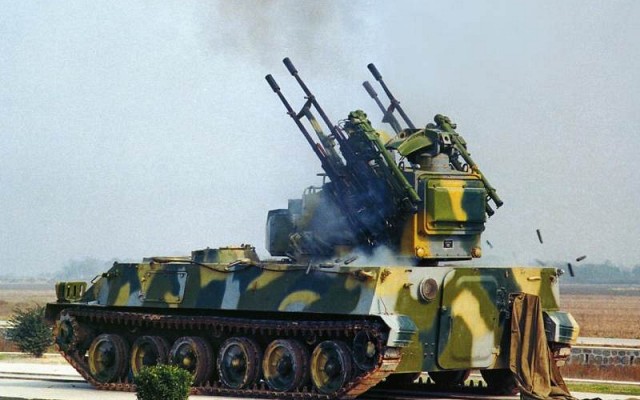
Type 90 III in test firing, note the unconventional camouflage
PGZ95 (also known as Type 95) is the self-propelled anti-aircraft artillery (SPAAA) system for low-level air defence. The system was designed and developed by the Northwest Institute of Mechanical & Electrical Engineering based at Xianyang, Shaanxi province. The system entered service with the PLA ground forces in the late-1990s for the air defence role in armoured troops at brigade and regiment level. The weapon system has also been marketed by the state-owned arms trade company NORINCO to potential foreign customers.
The SPAAA system, once known as Type 90-II or Type 90-III in development stage, may have benefited from the Italian SIDAM-25 technology. The SIDAM-25 is fitted with four Oerlikon Contraves 25mm KBA cannons. The PRC reportedly obtained at least one SIDAM-25 turret in the mid-1980s. The 25mm cannon of the PGZ95 was based on the Type 87 towed 25mm AAA gun introduced in the mid-1980s.
Development of a SPAAA intended to provide air defence for armoured troops began in the mid-1980s. Initially it was designed as a semi-automated system, with a primitive electro-optic (TV) director for day time operation. Later the PLA demanded the system to be fully automated, with both TV and radar tracking, a computerised fire-control with laser rangefinder input, and the ability to fire on the move. Following the 1990s Gulf War, the PLA issued refreshed requirements, which demanded the system to have all-weather, day/night operation capability and the integration of the air defence missile for longer range engagement.
The PGZ95 was first revealed to the public during the 1999 national day military parade held in Beijing, while it may have reached initial operational capability (IOC) few years earlier. The PGZ95 is much more capable than the previous indigenous SPAAA designs. The system can operate in day/night, all-weather conditions, and can be added with four QW-2 short-range SAM to form a SPAAA/SAM system that capable of engaging all threat targets, including fixed-wing aircraft, helicopters, and unmanned aerial vehicles (UAV). The weapon system is found in the air defence company of an armoured brigades or regiment.
The PGZ95 can be fitted with four QW-2 IR-homing, short-range surface-to-air missiles. The missile is derived from the shoulder-launched variant QW-2 (MANPADS), a close copy of the Russian Igla-1 (SA-16 Gimlet). Claimed effective altitude ranges indeed from 10 to 3,500m, slant ranges up to 6,000m. In a typical target engagement the SAM would be used to engage targets at longer ranges, The QW-2 Operational range is 0.5 up to 6 kilometres (0.31–3.73 mi) with a flight ceiling of 4 kilometres (2.4855 mi).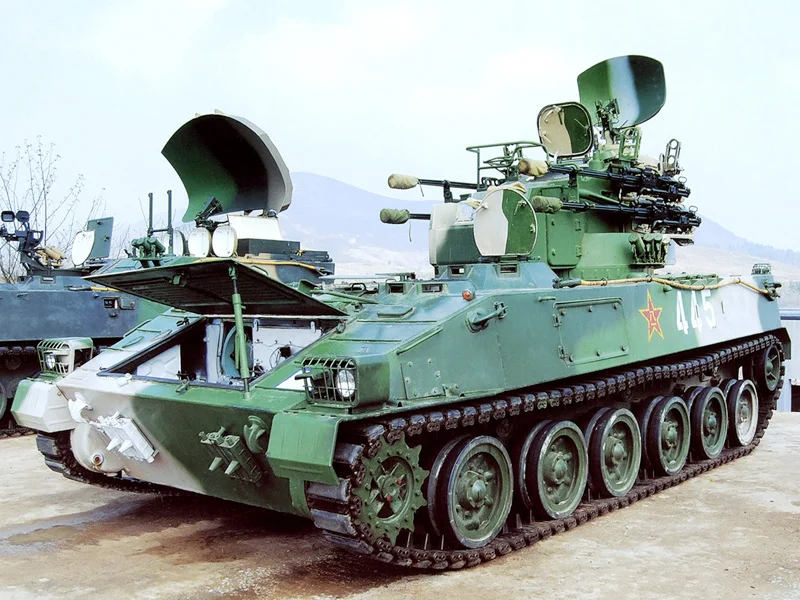
An electro-optic director mounted on the forward part of the turret includes a TV tracking camera, infrared tracking camera and a laser rangefinder which feeds information to the onboard fire-control computer. This calculates the weapon-laying data, and when the target is within range the gunner opens fire. The gunner also has a joystick with which to lay the weapons onto the target.
The TV tracker has a maximum automatic tracking range of 6,000m while the infrared tracking camera has a maximum range of 5,000m. The laser range-finder is quoted as having a minimum range of 500m, maximum range of 5,500m and is accurate to +/- 5m.
The PGZ95 is also fitted with a CLC-1 low altitude target search radar installed on the roof of the armament turret. The radar is working at S-band and has a detection range of 11km. The radar antenna is mounted on top of the turret. When the vehicle is travelling, the radar antenna can be folded down forwards to reduce the overall height of the system. System reaction time depends on a number of factors. According to NORINCO, in the radar search mode this is 10 seconds while in the optical mode it is about 6 seconds.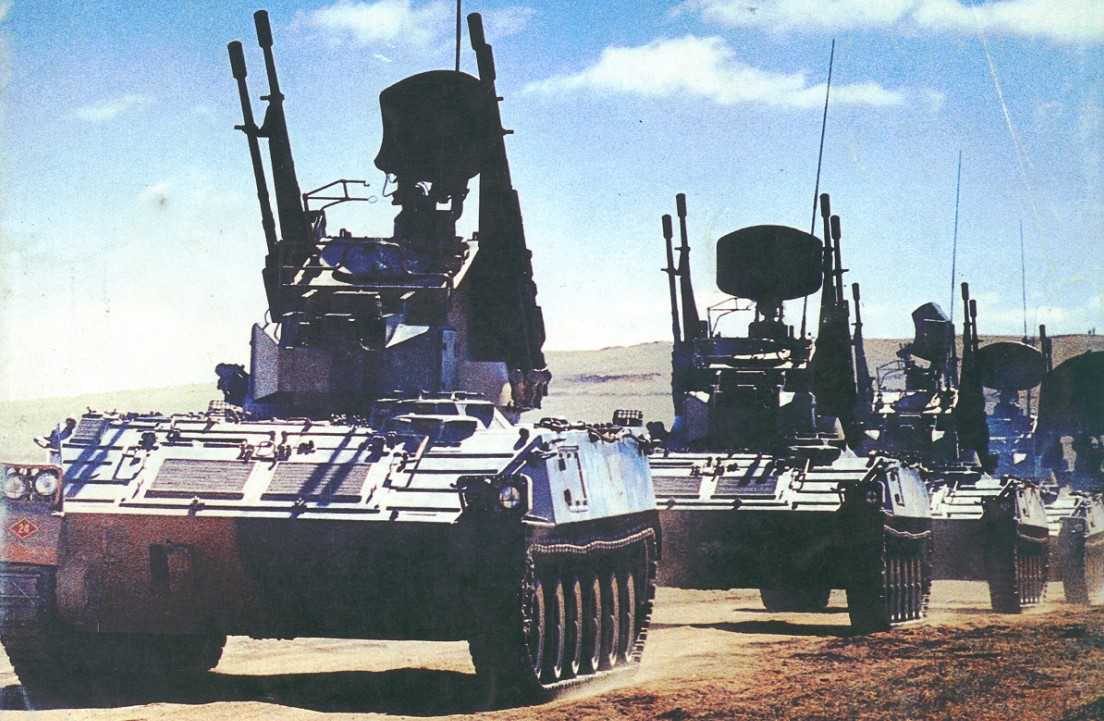
As deployed, the typical Type 95 battery comprised six SPAAA and a single command vehicle and is supported by three ammunition re-supply trucks and a test/repair truck as well as a power supply truck. The type is gadually replaced in some units since 2009 by the PGZ-09 SPAA. It is based on the PLZ-05 self-propelled howitzer chassis, with two 35 mm autocannons similar to the PG-99 towed AA gun completed by four infrared guided MANPADS, probably FN-12 type.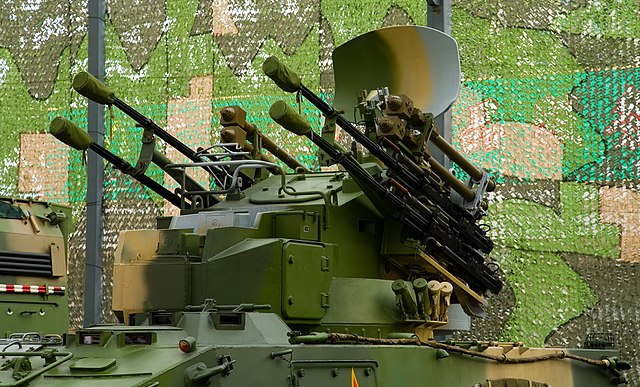
Improved model with lengthened chassis and better integration with the battery command vehicles as well as fitted with the new longer-range FN-6 infrared homing missile. Next evolution of the SPAA in PLA service. The FN-6 weights 16 kg and is 1,495mm long, of a diameter of 72mm, using a single Stage Solid Rocket Motor to accelerate to 600m/s or Mach 1.74, max range of 6,000 meters, altitude 3,800 meters. It is otherwise pretty similar in all aspects to the original PGZ-95, with the same level of protection.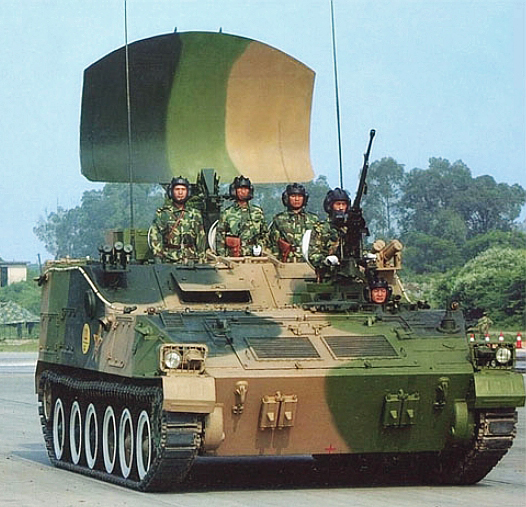
The PGZ95 SPAAA is part of a complete mobile air-defence system that also includes a battery command vehicle. Mounted on a similar chassis, the command vehicle has a raised superstructure at the rear hull to provide greater internal volume. The vehicle can typically be used to control up to 6~8 SPAAA/SAM systems.
Mounted on top of the command vehicle is a S-band CLC-2 PD surveillance radar with a maximum range of 45km and a maximum altitude of up to 4.5km. The CLC-2 search radar feeds information to the data processing system that in turn allocates target information to the individual SPAAG/SAM units. Communications equipment installed in the battery command vehicles allows it to transmit information in a digital form up to 5km, by standard radio up to 15km and by wire up to 500m.
The command vehicle is also provided with a navigation system and an auxiliary power unit needed to power the additional electronics mounted in the vehicle. The commander is seated to the rear of the driver and mounted above his cupola is a manually operated 12.7mm anti-aircraft machine gun (AAMG). A bank of four electrically operated smoke grenade launchers is mounted either side of the forward part of the raised superstructure.
A typical PGZ95 battery would consist of 6 SPAAA/SAM systems, one battery command vehicle, three ammunition re-supply vehicles, one battery testing vehicle and one power supply vehicle, all of which are mounted on the same 6x6 cross-country truck chassis. The crews of the PGZ95 can also be trained using a simulator for the gunner. The Command vehicle is less tall at 4.58/3.38 m radar up and down versus 4.82/3.4 m, and longer at 6.8 meters, but apparently with the same weight. It is armed with a single 12.7 mm HMG.
Design of the PGZ-95
Development

Type 90 III in test firing, note the unconventional camouflage
PGZ95 (also known as Type 95) is the self-propelled anti-aircraft artillery (SPAAA) system for low-level air defence. The system was designed and developed by the Northwest Institute of Mechanical & Electrical Engineering based at Xianyang, Shaanxi province. The system entered service with the PLA ground forces in the late-1990s for the air defence role in armoured troops at brigade and regiment level. The weapon system has also been marketed by the state-owned arms trade company NORINCO to potential foreign customers.
The SPAAA system, once known as Type 90-II or Type 90-III in development stage, may have benefited from the Italian SIDAM-25 technology. The SIDAM-25 is fitted with four Oerlikon Contraves 25mm KBA cannons. The PRC reportedly obtained at least one SIDAM-25 turret in the mid-1980s. The 25mm cannon of the PGZ95 was based on the Type 87 towed 25mm AAA gun introduced in the mid-1980s.
Development of a SPAAA intended to provide air defence for armoured troops began in the mid-1980s. Initially it was designed as a semi-automated system, with a primitive electro-optic (TV) director for day time operation. Later the PLA demanded the system to be fully automated, with both TV and radar tracking, a computerised fire-control with laser rangefinder input, and the ability to fire on the move. Following the 1990s Gulf War, the PLA issued refreshed requirements, which demanded the system to have all-weather, day/night operation capability and the integration of the air defence missile for longer range engagement.
The PGZ95 was first revealed to the public during the 1999 national day military parade held in Beijing, while it may have reached initial operational capability (IOC) few years earlier. The PGZ95 is much more capable than the previous indigenous SPAAA designs. The system can operate in day/night, all-weather conditions, and can be added with four QW-2 short-range SAM to form a SPAAA/SAM system that capable of engaging all threat targets, including fixed-wing aircraft, helicopters, and unmanned aerial vehicles (UAV). The weapon system is found in the air defence company of an armoured brigades or regiment.
Protection
The PGZ95 has a crew of three (commander, gunner and driver), for a combat weight of 22.5 tonnes. The commander is seated to the immediate rear of the driver and is in overall command of the engagement, receiving target information from the battery command post. It is lightly armoured, not for frontline engagements. The chassis is made in rolled steel (RHA) and just thick enough to stop 12.7 mm rounds on the forward arc, while the sides and rear are protected against only 8 mm fire, as well as shrapnel. To be precised, there is 10 mm (69°) for the upper glacis, 12 mm (36°) for the lower plate and 8 mm (11°) on Top, same on the bottom (7°). The turret is similarly protected by 8 mm all around (0.3 inches), so that any round above 12.7 mm can penetrate it with ease. For active protection, there is a bank of four electrically operated forward-firing smoke grenade launchers is mounted either side on the lower part of the turret.Propulsion & Mobility of the PGZ-95
The PGZ95 consists of a tracked chassis with six 20 mm thick roadwheels, three return rollers, and tracks 15 mm thick, with six torsion bars 22 mm thick. Drive sprockets are at the front, where the engine compartment is laid out, and idlers at the rear. The unknown type diesel engine is rated for 500 horsepower, and performances are as follows: 53 kph on road (33 mph), and 450 km ion range (280 miles). It seems the same for the PGZ-04 successor.Armament
The 25mm cannon, which was already in service with the PLA in other applications before the introduction of the PGZ95, has a cyclic rate of fire of 600 to 800 rounds per minute per barrel. About 1,000 rounds of 25mm ammunition are carried, and the empty cartridge cases are ejected outside of the turret. The system can be reloaded via an automatic loading mechanism. The 25mm cannon also has a secondary role against ground targets and would be able to destroy most light armoured fighting vehicles. The 25mm cannons are used ion the first bubble of protection, engaging aircraft and helicopters at up to 2,500m and an 2,000m altitude.The PGZ95 can be fitted with four QW-2 IR-homing, short-range surface-to-air missiles. The missile is derived from the shoulder-launched variant QW-2 (MANPADS), a close copy of the Russian Igla-1 (SA-16 Gimlet). Claimed effective altitude ranges indeed from 10 to 3,500m, slant ranges up to 6,000m. In a typical target engagement the SAM would be used to engage targets at longer ranges, The QW-2 Operational range is 0.5 up to 6 kilometres (0.31–3.73 mi) with a flight ceiling of 4 kilometres (2.4855 mi).
Fire Control

An electro-optic director mounted on the forward part of the turret includes a TV tracking camera, infrared tracking camera and a laser rangefinder which feeds information to the onboard fire-control computer. This calculates the weapon-laying data, and when the target is within range the gunner opens fire. The gunner also has a joystick with which to lay the weapons onto the target.
The TV tracker has a maximum automatic tracking range of 6,000m while the infrared tracking camera has a maximum range of 5,000m. The laser range-finder is quoted as having a minimum range of 500m, maximum range of 5,500m and is accurate to +/- 5m.
The PGZ95 is also fitted with a CLC-1 low altitude target search radar installed on the roof of the armament turret. The radar is working at S-band and has a detection range of 11km. The radar antenna is mounted on top of the turret. When the vehicle is travelling, the radar antenna can be folded down forwards to reduce the overall height of the system. System reaction time depends on a number of factors. According to NORINCO, in the radar search mode this is 10 seconds while in the optical mode it is about 6 seconds.
Production and Variants

As deployed, the typical Type 95 battery comprised six SPAAA and a single command vehicle and is supported by three ammunition re-supply trucks and a test/repair truck as well as a power supply truck. The type is gadually replaced in some units since 2009 by the PGZ-09 SPAA. It is based on the PLZ-05 self-propelled howitzer chassis, with two 35 mm autocannons similar to the PG-99 towed AA gun completed by four infrared guided MANPADS, probably FN-12 type.
Main PGZ-95
Also called Type 95 SPAAA, made part or the totality of the 270 estimated produced so far.PGZ-04/A

Improved model with lengthened chassis and better integration with the battery command vehicles as well as fitted with the new longer-range FN-6 infrared homing missile. Next evolution of the SPAA in PLA service. The FN-6 weights 16 kg and is 1,495mm long, of a diameter of 72mm, using a single Stage Solid Rocket Motor to accelerate to 600m/s or Mach 1.74, max range of 6,000 meters, altitude 3,800 meters. It is otherwise pretty similar in all aspects to the original PGZ-95, with the same level of protection.
PGZ-95 battery vehicle

The PGZ95 SPAAA is part of a complete mobile air-defence system that also includes a battery command vehicle. Mounted on a similar chassis, the command vehicle has a raised superstructure at the rear hull to provide greater internal volume. The vehicle can typically be used to control up to 6~8 SPAAA/SAM systems.
Mounted on top of the command vehicle is a S-band CLC-2 PD surveillance radar with a maximum range of 45km and a maximum altitude of up to 4.5km. The CLC-2 search radar feeds information to the data processing system that in turn allocates target information to the individual SPAAG/SAM units. Communications equipment installed in the battery command vehicles allows it to transmit information in a digital form up to 5km, by standard radio up to 15km and by wire up to 500m.
The command vehicle is also provided with a navigation system and an auxiliary power unit needed to power the additional electronics mounted in the vehicle. The commander is seated to the rear of the driver and mounted above his cupola is a manually operated 12.7mm anti-aircraft machine gun (AAMG). A bank of four electrically operated smoke grenade launchers is mounted either side of the forward part of the raised superstructure.
A typical PGZ95 battery would consist of 6 SPAAA/SAM systems, one battery command vehicle, three ammunition re-supply vehicles, one battery testing vehicle and one power supply vehicle, all of which are mounted on the same 6x6 cross-country truck chassis. The crews of the PGZ95 can also be trained using a simulator for the gunner. The Command vehicle is less tall at 4.58/3.38 m radar up and down versus 4.82/3.4 m, and longer at 6.8 meters, but apparently with the same weight. It is armed with a single 12.7 mm HMG.
PGZ-95 specifications | |
| Dimensions | 6.71 x 3.2 x 3.4 m* (20 x 10 ft 6 in x 11 ft 2 in*) *radar down |
| Total weight, battle ready | 22.5 tons |
| Crew | 3 |
| Propulsion | Diesel engine, specs unknown |
| Suspension | Torsion bar |
| Speed (road/water) | 53 km/h (33 mph) |
| Range | 450 km (280 mi) |
| Armament | 4× 25 mm autocannons 4× QW-2 missiles |
| Armor | RHA, Protection against 14mm rounds fwd, see notes |
| Total production | c270 |
Gallery
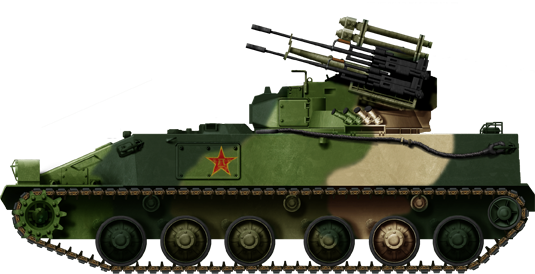
Base Type 95, PGZ-95 as presented in Beijing, 1999
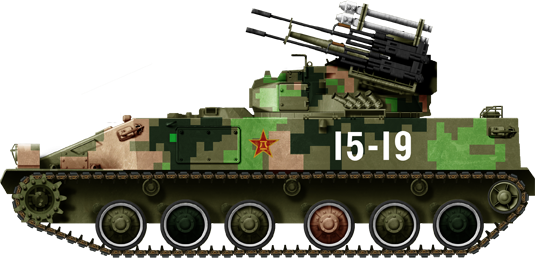
PGZ-95, digital camouflage in parade
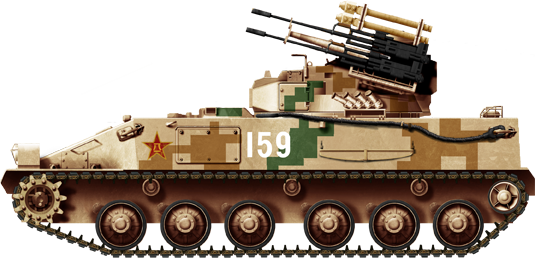
PGZ-95 in nortwestern camouflage

Type 95
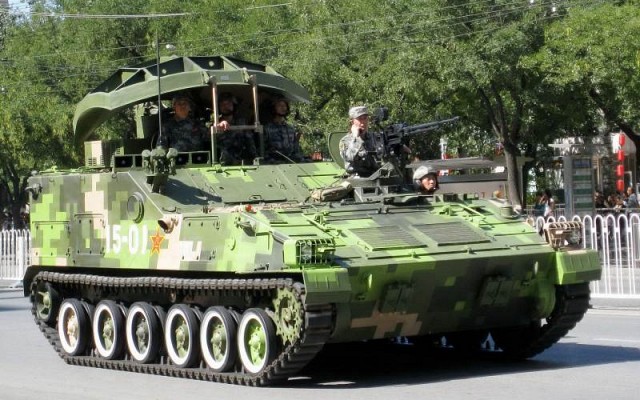
Command battery vehicle
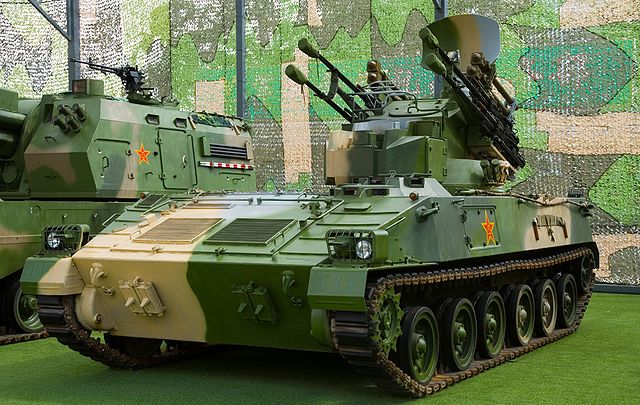
Beijing presentation, 1999

Turret closeup
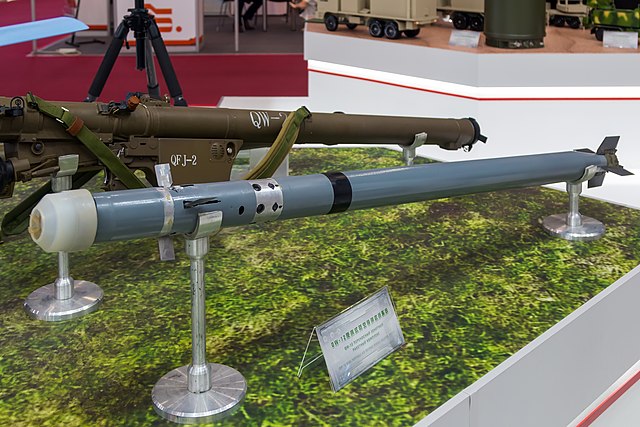
QW-12 MANPADS of the PGZ-95
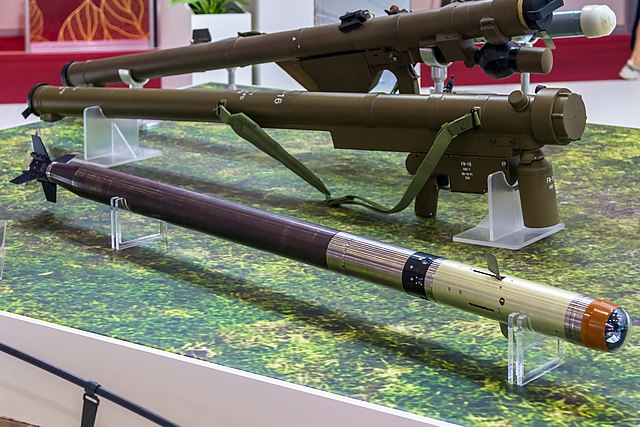
FN-16 MANPADS of the PGZ-04A
Links/Src
James C O'Halloran. Jane's Land Based Air Defence 2005–2006.links
globalsecurity.orgmilitarytoday.com
army-technology.com
weaponsystems.net
www.sinodefence.com
militaryfactory.com PGZ-04A
armyrecognition.com, compar. PGZ 95/04A
militaryfactory.com PGZ-95
Video

Modern Tanks
Modern MBTs posters

Denel Bagder (2018)

Type 16 MCV (2016)

Gepard 1A2 last rounds 2011

SANDF

Russian AFVs

Main Battle Tanks

